
Hummingbirds – so called because of the sound that their wings make – are one of the most fascinating types of bird around, with their long beaks and extraordinary ability to feed while hovering in mid-air. Widespread across most of America, there are currently around 360 species today with a vast array of vibrant colours and fascinating tail shapes. Although hummingbirds are not the biggest birds you will find, here are the 10 largest hummingbirds in the world ranked by length.
#10 Largest Hummingbird: Green-Crowned Brilliant Hummingbird
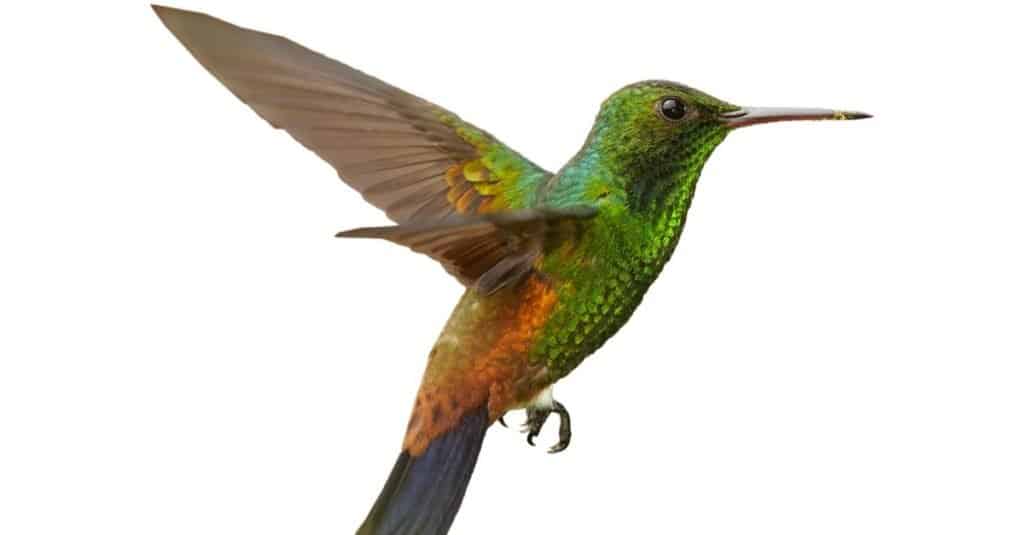
A green-crowned brilliant hummingbird has a blue patch on the throat and a black-blue tail.
©Martin Mecnarowski/Shutterstock.com
First on the list in the green-crowned brilliant hummingbird which can reach a length of around 5.1 inches for males with females being slightly smaller. Found mainly in forests in the mountain regions of the Caribbean, these hummingbirds are emerald green with a blue patch on their throat and a black-blue tail. Females are slightly different as they have a white stripe near their eyes and green spots on their bellies. Green-crowned brilliant hummingbirds usually nest on branches that slope downwards and only the female builds the nest, incubates the eggs and raises the chicks as the male leaves her shortly after they have mated.
#9 Largest Hummingbird: Rivoli’s Hummingbird
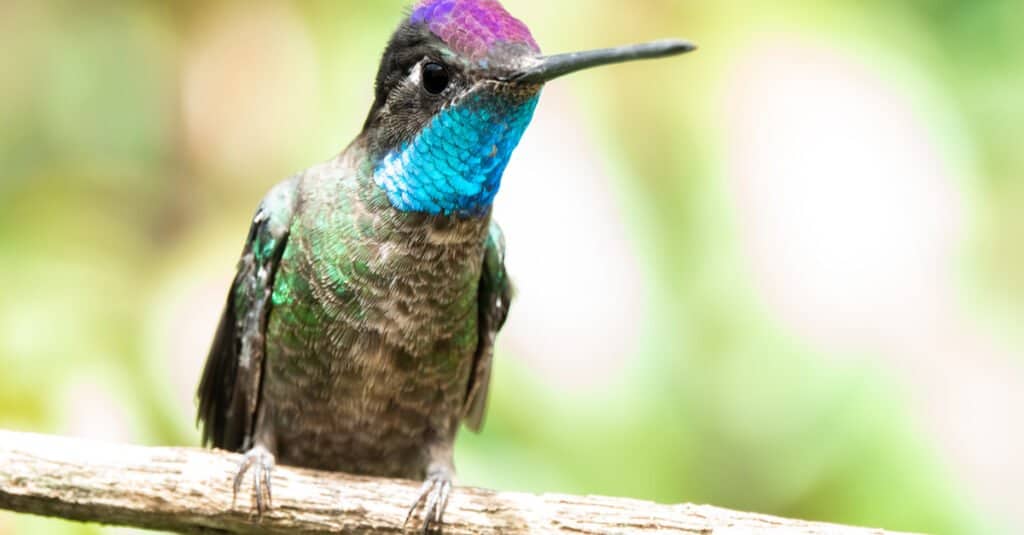
The Rivoli’s hummingbird can reach more than 5 inches
©Jeroen Mikkers/Shutterstock.com
Rivoli’s hummingbird is found in mountainous forests and canyons from Honduras and Nicaragua to the southwestern region of the United States. They can reach lengths of 5.25 inches and have a wingspan of around 7 inches, although females are slightly smaller than males. Rivoli’s hummingbirds have a unique appearance with a green-blue throat, purple crown, and purple-green wings. The female is responsible for building the nest – which is usually in trees overhanging streams – and for incubating the eggs, although the males are known to be extremely protective and territorial. They feed mainly on nectar from flowers, but also on small insects and spiders.
#8 Largest Hummingbird: Tooth-Billed Hummingbird

The tooth-billed hummingbird has a long, straight bill with tooth-like structures on it.
©Donald T. Devine/Shutterstock.com
Tooth-billed hummingbirds live in the humid forest regions of Colombia, Ecuador, and Panama and reach lengths of 5.5 inches. Their name comes from their bill, which is long and straight but has small tooth-like structures on it. Tooth-billed hummingbirds are green with a red-brown crown and a light fawn belly with white streaks while their tail is grey with black and white markings. They are one of the lesser-known species of hummingbird and little is known about them, but their serrated bill is ideal for catching small spiders and other insects.
#7 Largest Hummingbird: Sword-Billed Hummingbird
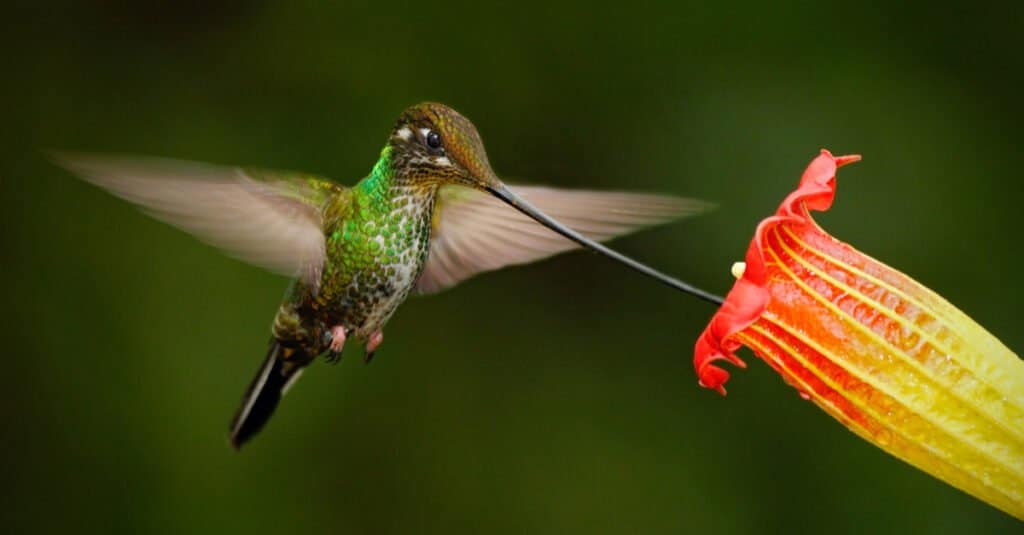
Sword-billed hummingbirds have an unusual appearance
©Ondrej Prosicky/Shutterstock.com
Sword-billed hummingbirds are one of the most unusual species as they have an extremely long bill, hence their name. While they have a total length of 5.5 inches, their bill actually makes up most of this length as they have a small body. What makes them even more unusual is that young sword-billed hummingbirds are born with a small bill, which then grows faster than their body does, and they have an extra long tongue as well to match their long beak. These fascinating birds favor tropical forests in Bolivia, Colombia, Ecuador, Peru, and Venezuela and they don’t migrate. Both males and females are a bright green with a reddish-brown head, although females have white spots on their throats.
#6 Largest Hummingbird: Long-Billed Hermit

Long-billed hermits can reach nearly 6 inches in length
©iStock.com/Salinger
Long-billed hermits are another species of hummingbird that has an unusually long beak, although not as long as that of the sword-billed hummingbird. The species is dark green with blue-green wings and a brown face. They are found in Colombia, Ecuador, Mexico, and Venezuela and usually prefer the undergrowth near water sources in forest regions. Long-billed hermits can reach lengths of around 5.9 inches and feed on insects, spiders, and the nectar from passion flowers. The males sing in groups to attract a female who then chooses the best singer to mate with, although after mating the female is left to construct the nest and hatch out the chicks without any help from the male.
#5 Largest Hummingbird: Violet Sabrewing
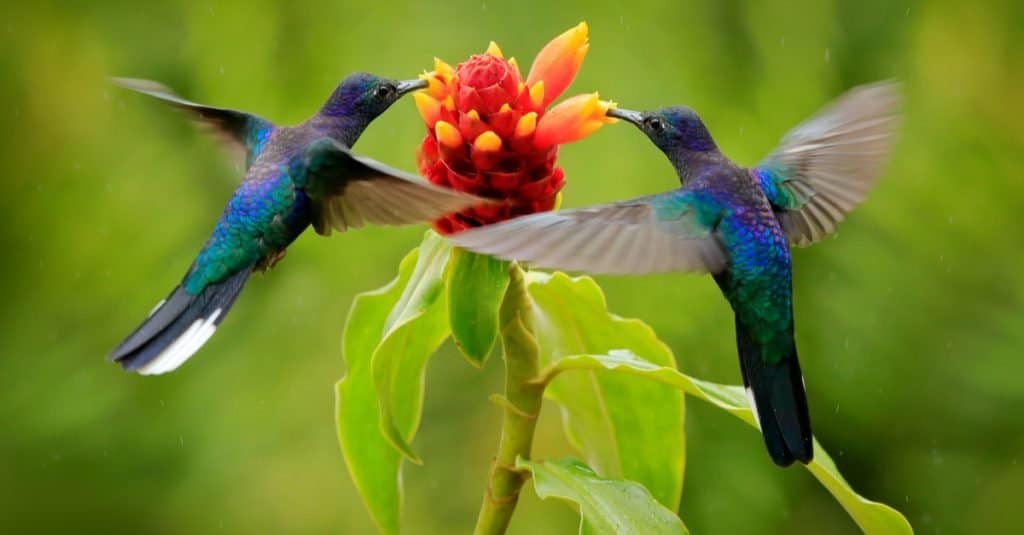
Blue hummingbird, Violet Sabrewing, flying next to a beautiful red flower, sucking nectar in a tropical forest in Costa Rica.
©Ondrej Prosicky/Shutterstock.com
The violet sabrewing hummingbird is a stunning bird with males having violet bodies and green backs and wings. Females are green on their back and wings and grey on their bellies and breast, although they have a violet patch on their throat. Found across Central America and Mexico, they usually live in the outskirts of mountainous forests or near streams. Despite reaching lengths of around 5.9 inches, these large hummingbirds are not particularly territorial or aggressive towards others. Females lay two eggs per year and they make their nests on a low branch which usually overhangs a stream.
#4 Largest Hummingbird: Marvelous Spatuletail
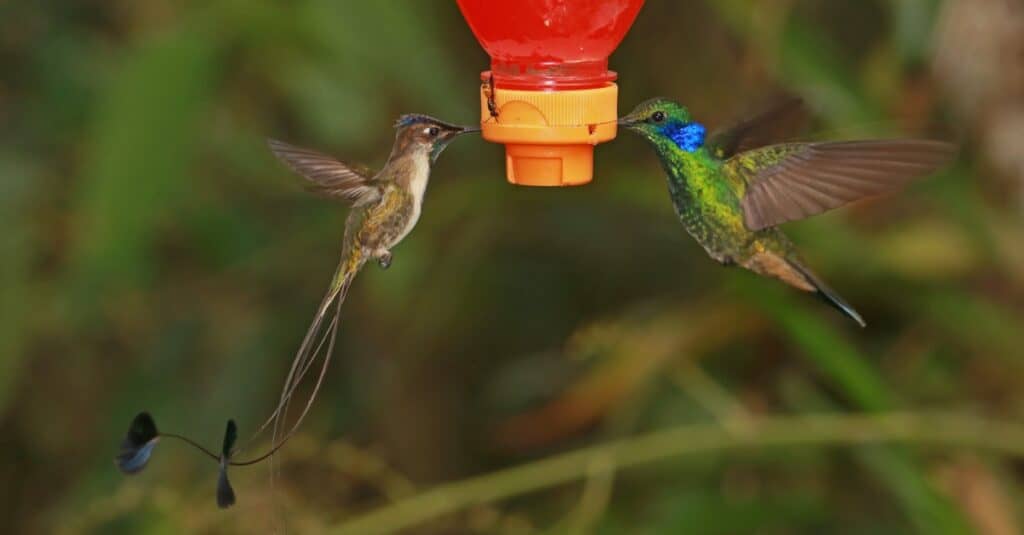
The marvelous spatuletail (on the left) is one of the most unique hummingbirds
©iStock.com/neil bowman
The marvelous spatuletail hummingbird really does live up to its name as it is one of the most unique and fascinating hummingbirds around. Reaching lengths of around 5.9 inches, these hummingbirds are endemic to the Utcubamba Valley in northern Peru where they can be found at the edges of forests. Marvelous spatuletails are a combination of green, white, and turquoise blue, but what makes these birds so unique is that they only have four tail feathers.
Although they are not the biggest hummingbird by body size, their tail makes them on of the longest as it consists of two long wire-like outer feathers and two inner feathers and the outer feathers cross each other and end in large turquoise discs. These extra long feathers can often be three or four times the length of the bird and the males are able to move each tail feather independently during extravagant courtship rituals. There is estimated to be less that 1,000 of these hummingbirds left and they are classed as an endangered species.
#3 Largest Hummingbird: Swallow-Tailed Hummingbird
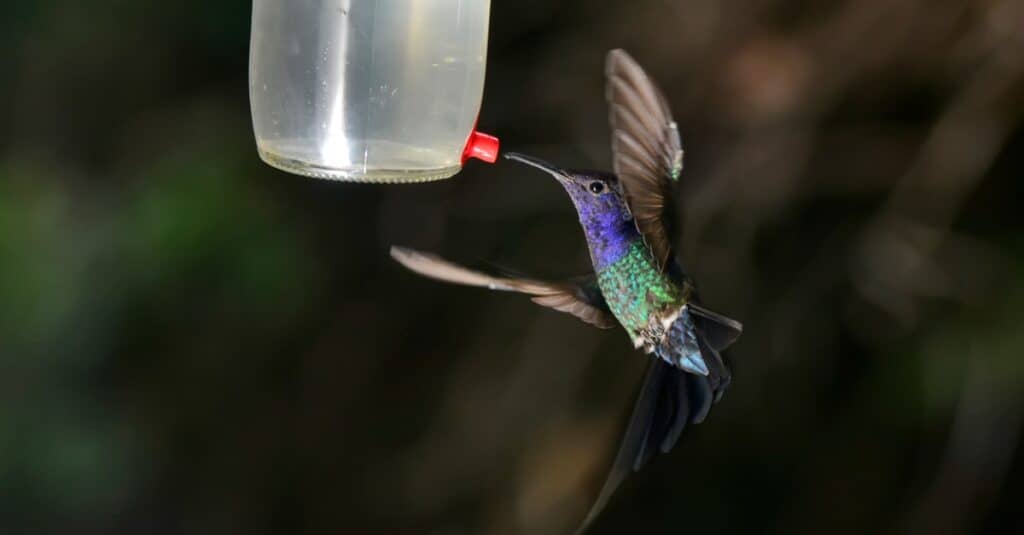
Swallow-tailed hummingbirds can reach nearly 7 inches in length
©Leonardo Mercon/Shutterstock.com
The swallow-tailed hummingbird is another species that is best known for its unique tail which is forked and has the same shape as a swallow’s tail. These hummingbirds are found mainly near to rivers across Brazil, Bolivia, and Paraguay. With a length of around 6.7 inches, they are large birds and are usually green with a blue head, chest, and tail. Their unusual tail makes up around half of their length and makes them easily recognizable. Swallow-tailed hummingbirds make their nests out of plants, moss, and lichen, and it is held together with sticky cobwebs.
#2 Largest Hummingbird: Long-Tailed Sylph
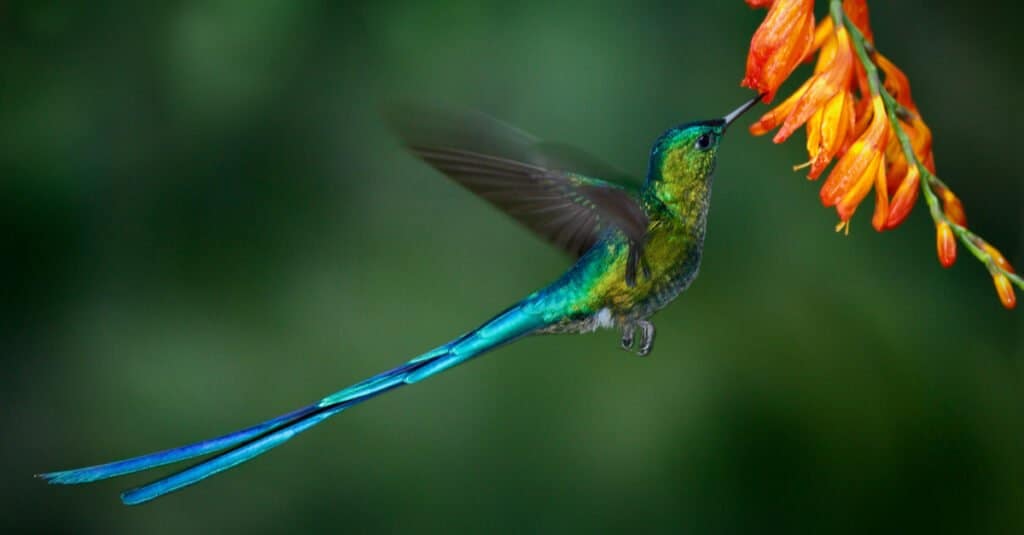
Long-tail sylph hummingbirds live across tropical forests in South America
©Ondrej Prosicky/Shutterstock.com
With a length of 7.5 inches, the long-tailed sylph hummingbird reaches the second spot. This stunning bird is emerald green with a blue throat and tail and is found in the tropical forests of Bolivia, Colombia, Ecuador, Peru, and Venezuela. Male long-tailed sylphs have extremely long tail feathers and their tails are so long and heavy that they make it difficult for them to fly. Females choose the males with the longest tail feathers as mates as they see it as a sign of them being the fittest and healthiest as they have managed to survive the winter while carrying the extra weight of their long tails. Males are territorial while females take full responsibility for nest making and incubating.
#1 Largest Hummingbird: Giant Hummingbird
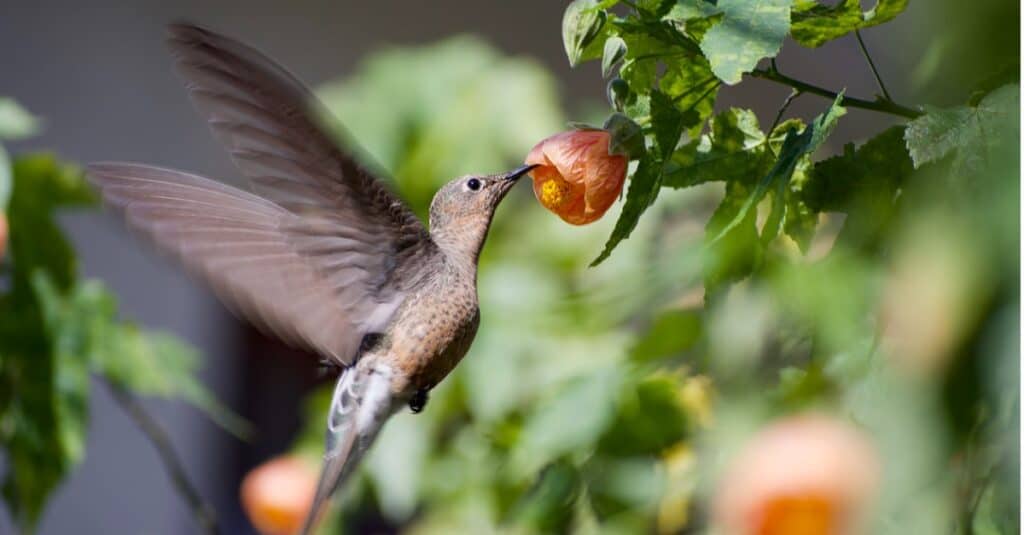
Giant hummingbirds can reach up to 9 inches in length!
©Carlos M. Werner/Shutterstock.com
The largest hummingbird in the world is the giant hummingbird which can reach a length of 9.1 inches. Preferring to live in forests and on scrubland, they are widespread across Argentina, Bolivia, Chile, Ecuador, and Peru. Unlike a lot of the other species, giant hummingbirds are not particularly brightly colored and are mainly various shades of brown. Nectar is their main source of food and they play an important role in the pollination of flowers. Giant hummingbirds lay two eggs during the summer months and their nest is usually near a stream or river. Giant hummingbirds are migratory and they travel north during the winter to warmer areas.
Summary of the 10 Largest Hummingbirds in the World
| Rank | Name | Size in Inches | Location |
|---|---|---|---|
| 1. | Giant Hummingbird | 9.1 | Forests and scrubland in Argentina, Bolivia, Chile, Ecuador, and Peru. |
| 2. | Long-tailed Sylph | 7.5 | Tropical forests of Bolivia, Colombia, Ecuador, Peru, and Venezuela. |
| 3. | Swallow-tailed Hummingbird | 6.7 | Near rivers across Brazil, Bolivia, and Paraguay. |
| 4. | Marvelous Spatuletail | 5.9 | Forest edges in northern Peru. |
| 5. | Violet Sabrewing | 5.9 | Outskirts of mountainous forests or near streams in Central America and Mexico. |
| 6. | Long-billed Hummingbird | 5.9 | Undergrowth near water sources in forest regions of Colombia, Ecuador, Mexico, and Venezuela. |
| 7. | Sword-billed Hummingbird | 5.5 | Tropical forests in Bolivia, Colombia, Ecuador, Peru, and Venezuela. |
| 8. | Tooth-billed Hummingbird | 5.5 | Humid forest regions of Colombia, Ecuador, and Panama. |
| 9. | Rivoli’s Hummingbird | 5.25 | Mountainous forests and canyons from the Southwest United States to Honduras and Nicaragua. |
| 10. | Green-Crowned Brilliant Hummingbird | 5.1 | Mountain forests in the Caribbean. |
The photo featured at the top of this post is © Ondrej Prosicky/Shutterstock.com
Thank you for reading! Have some feedback for us? Contact the AZ Animals editorial team.






